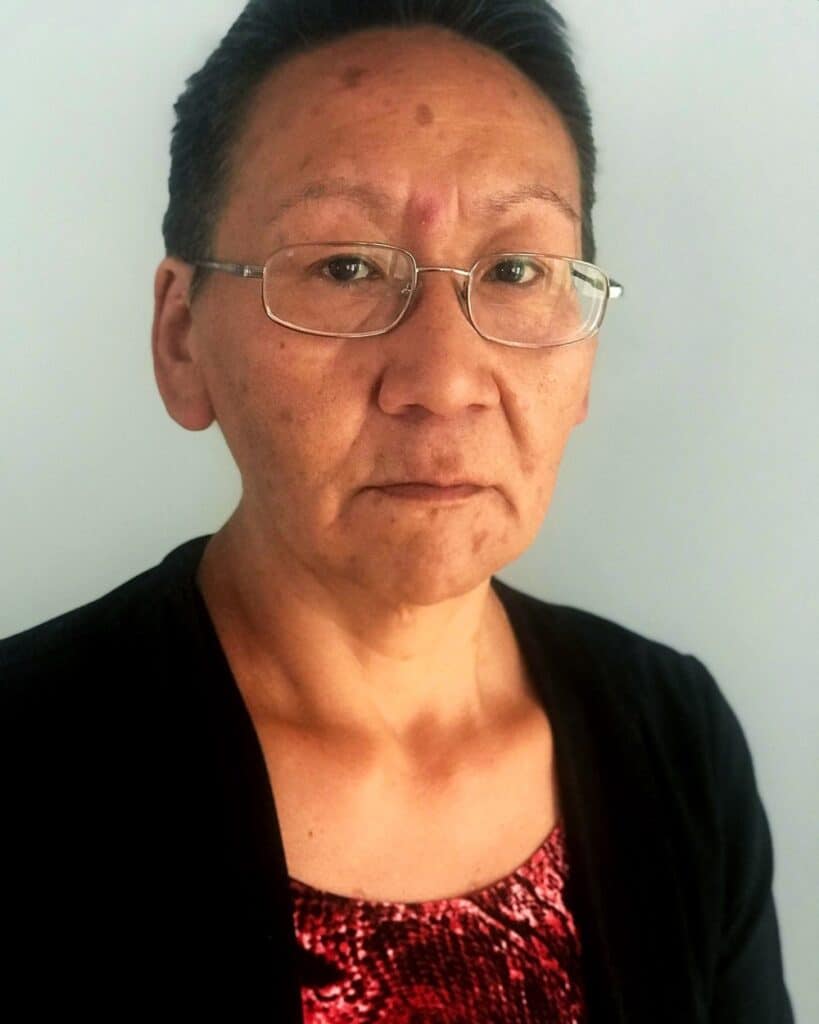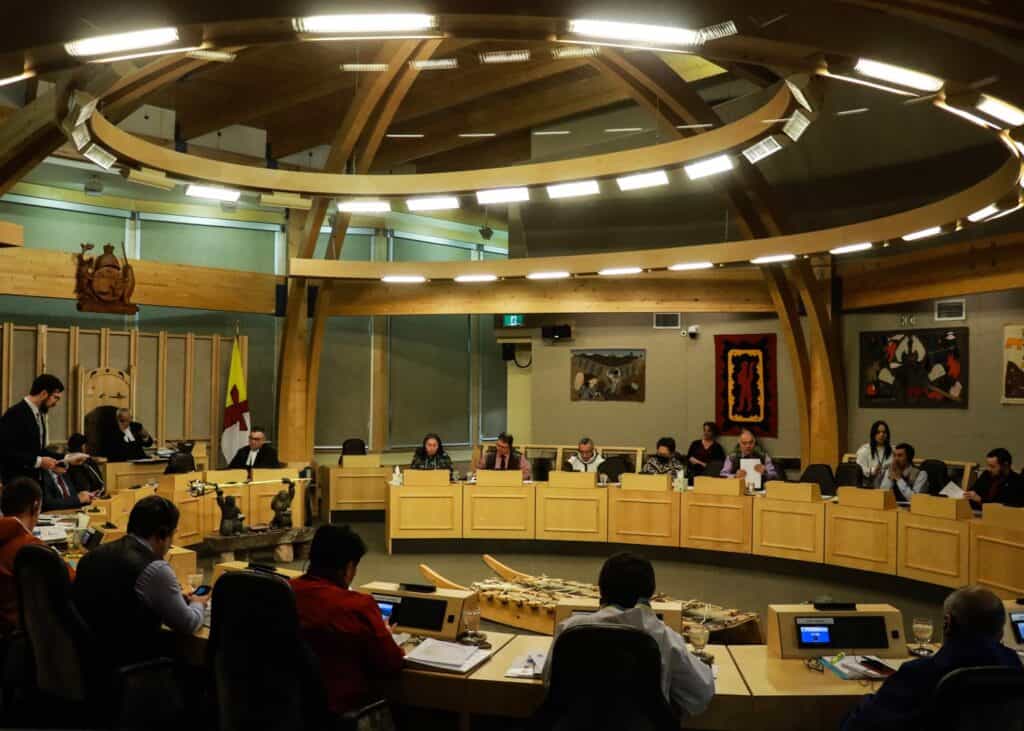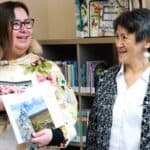How unique digital initiatives are bringing Inuktut to every screen
By Meral Jamal • Photos Courtesy of Meral Jamal

Jeela Palluq-Cloutier had been teaching and sharing Inuktitut for years when the Pirurvik Centre, a learning facility based in Iqaluit, asked for her help with a unique project.
An educator at heart, she’d spent over two decades teaching in classrooms, interpreting and translating at events, and producing resources such as books in the language.
“Through different ways, I’ve been contributing to making our language visible out there.”
Having worked with a host of organizations—Pirurvik, Inhabit Media, and Inuit Uqausinginnik Taiguusiliuqtiit, which is the Inuit Language Authority in Nunavut—Palluq-Cloutier had a wealth of experience, as well as versatility and adaptability in how and for whom she built Inuktut resources.
It was her knowledge of the language and her experience with translation that she tapped into when Pirurvik asked her to bring Inuktut into the digital world. The first time, in 2005, involved translating the Microsoft interface into Inuktitut. This included translating words that were completely new to Inuktitut, like flash drive, internet, and e-mail. For Palluq-Cloutier, this meant a lot of interpretation. For example, the word “internet” became “ikiaqqivik,” an old word associated with shamans and their ability to travel around to others without leaving their bodies. Considering how much news the internet makes available at one’s fingertips, the word was deemed appropriate.
Now, more than 15 years later, her work has moved to translating Facebook’s desktop interface into Inuktitut as well. In collaboration with Pirurvik, Palluq-Cloutier was able to pull from her earlier work with Microsoft, but there were still challenges, particularly around differences in word length and language structure.
Inuktut as Culture and Heritage
Inuktut encompasses five main Inuit languages spoken across the country, according to Statistics Canada, including Inuvialuktun, Inuinnaqtun, and three dialects of Inuktitut. For a language that is older than Canada—and of course, the internet—attempts to bring Inuktut to the digital world are not a new endeavour.
Before companies like Microsoft and Meta (the parent company of Facebook) took an interest in the language, Inuit on the ground were already adapting Inuktut to bring it online.
A successful example is the Inuinnaqtun revitalization that the Kitikmeot Heritage Society (KHS) has been spearheading from Cambridge Bay. An Inuit-led charitable organization that has been around for over 25 years, KHS focuses on the priorities of Inuinnait—a distinct regional group of Inuit living in the Central Canadian Arctic, according to the society’s website.
KHS aims to revitalize Inuinnait culture and maintain the passing of knowledge across generations by reawakening the Inuinnaqtun language, reclaiming identity, and recording knowledge of and resources in Inuinnaqtun, “so that generations to come will inherit the connection to our ancestors and their knowledge, values, and worldview.”
Over the years, KHS has spearheaded the learning and use of Inuinnaqtun in a myriad of ways. Successful examples include hosting language courses, creating digital atlases that share knowledge of the land and Inuit who live on it, publishing learning resources such as books and dictionaries, and conducting oral interviews with Elders in Cambridge Bay who grew up on the land speaking fluent Inuinnaqtun and have first-hand experience with living the traditional Inuinnait life.
Emily Angulalik, President of KHS, says one of the primary goals for revitalizing Inuinnaqtun is to reclaim culture and tradition.
“We know that colonization has impacted many of our people. But we can regain our language and our culture through [language] programs and projects—and it’s at our own time and at our own pace,” Angulalik says, adding that “revitalization has to be at the personal level.”
While other societies and regional Inuit associations invest in cultural and traditional activities in their own ways, Angulalik notes the revitalization of Inuktut will help more Inuit heal from the trauma of their past.
“We’re in this era of healing. We’re in the era of moving forward and [Inuinnaqtun revitalization is] just enriching.”
Inuktut for All Generations
According to Angulalik, a big reason the heritage society has digitized many of its Inuinnaqtun language resources is to help bridge the gap between older and younger Inuit.
Through its online Inuinnaqtun Language Atlas, for example, speakers of all levels can look up words for actions like walking slowly, wearing certain clothing, or describing something as beautiful. They can also listen to audio pronunciation to know how the word is said.
“There have been changes happening over the years, as well as impacts from them today,” Angulalik says. “One of them is that our youth are not speaking [our language] as much as they could be.”
Angulalik points out that digitizing Inuktut will help reach young learners where they are most engaged: online. It will also help make technology more accessible for older Inuit who want to use digital devices and the internet in their own language. Ultimately, Angulalik says digital language resources, such as those created by KHS, help Inuit of all ages learn at their own time and pace.
“Our younger generation, as the Elders would say, should really learn the language,” she says.
“But again, it’s about time and pace.”
For Angulalik, forcing Inuit across generations and lived experiences to learn their languages may hurt the learning process more than help it. According to her, it’s important to adapt to how, where, and when younger Inuit speak with Inuktut today.
“It’s important to accommodate our youth, our younger generation who are so used to technology.”
Inuktut Education
Palluq-Cloutier’s husband helped her translate 11,000 English words into Inuktitut for Facebook.
He helped her break down the large files sent along by Meta into smaller pieces of information to translate.
It took Palluq-Cloutier over two months to translate the entire desktop interface for Facebook’s social media website. What made the process easier was reusing some of the terms she had already translated for Microsoft.
Using Facebook in Inuktitut today, Palluq-Cloutier finds her translations to be both a source of pride and a little embarrassment.
The translation is a source of pride for her because growing up in Nunavut in the 1970s, much of her education took place in English.
“My English is very good because I was forced to speak and read and write in English,” Palluq-Cloutier recalls. “I’m good with my English but I wish I had had the chance [to learn Inuktitut].”
It’s also a little embarrassing because using Facebook in Inuktitut today, she sees “some mistakes” in some of the words she translated from English to Inuktitut.
“I know they are easily fixable … but I was a little embarrassed by the mistakes and also proud that our language can be out there in this way.”
Conversations about Inuktut use, especially in Nunavut’s education system, are ongoing within political circles and across communities.
The territorial education system currently provides instruction in Inuktitut only through Grade 4. While Inuktut classes are offered by the Nunavut Arctic College, the main language of instruction throughout schools and college campuses continues to be English.
With Nunavut celebrating Inuktut language month in April, the use and spread of the language, especially by younger Inuit, was most recently brought up in the winter sitting of the legislative assembly, which began on February 22, 2023.

Minister of Culture and Heritage Joanna Quassa presented the 2019–20 and 2020–21 reports at the assembly on February 28.
According to the 2020–21 report, the Culture and Heritage Department helped develop more than 200 new resources that were intended for Inuktut language learning: 117 in Inuktitut and 84 in Inuinnaqtun.
The report also highlights the role that platforms such as Microsoft Translator are playing in making Inuktut more accessible.
“The addition of Inuktitut to Microsoft Translator will allow access to Inuktitut for anyone with internet access via computer, phone, or tablet at home, at work, or in the classroom,” the report notes.
“This also creates opportunities for individuals and businesses requiring or providing Inuktitut language services.”

According to Palluq-Cloutier, the most important aspect of translated digital platforms such as Facebook and Microsoft Translator is the way they become learning and teaching tools themselves.
Even though she grew up without a formal education in Inuktitut, she says having Inuktitut as an option online is an opportunity “to use our own language.”
At the end of the day, however, it’s not only about creating such tools but ensuring their widespread use—across classrooms and communities.
“People will now have the availability and the choice to use these platforms,” Palluq-Cloutier says.
“That’s important—to be able to have the choice [of Inuktut] and to use it.”
Along with helping younger and older
Inuit practise using the language online, she hopes these platforms are a learning tool for people from all professions and walks of life, but especially for others like her.
“I am hoping that with my work … information that [needs] to be conveyed is properly done so in both languages.”
Often, Inuktut translators face challenges when translating English words that do not have an Inuktitut equivalent, or that may be jargon.
With Inuktitut now available on Facebook and Microsoft Translator, Palluq-Cloutier says she hopes other Inuit in her field of work have an easier time—that when they come across a complex or highly technical English word, they simply open their laptops, click on a website, enter the word in the search bar and find exactly what they’re looking for in Inuktut.

